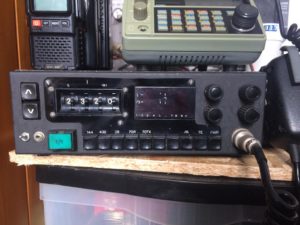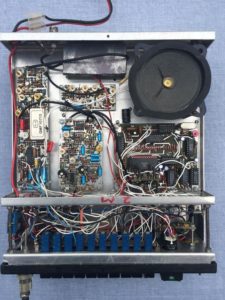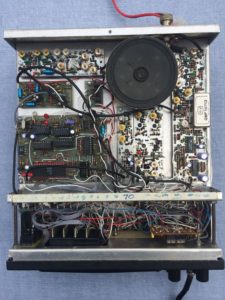
Top row – Up/Down keys, thumbwheels for S and SU channels, indicators for repeater functions and s-meter (formerly digital display), squelch and volume controls. Bottom row – Tx switch, aux audio input, talkthrough switch, switchbank, mic input.
Here’s the story of David de la Haye’s W&D Dual Bander which he kindly sent me pictures of, the words are David’s. I’m sure you’ll agree that it’s great to see some of these radios being resurrected and put on the air again.
In the early 80s, shortly after obtaining my G6 callsign, I decided I wanted to kit-build a VHF/UHF dual bander, and I selected Wood & Douglas gear.
I bought the kits in stages, probably (if memory doesn’t fail!) the crystal driven Rx first, then the synthesiser and Tx, then later a 2m 10w PA and preamp. (I built the PA in, but kept the preamp external in a die cast box.)
Later I bought all the 70cm kits in one hit.
I decided to create an aluminium chassis with three compartments, one for 2m RF, one for 70cms RF, and one for “controls”.
So the rig is essentially two totally separate radios in one box.

2m side – left to right, top row: loudspeaker, synth (with switch board over), Talkthrough relay board, middle row – 10w PA in box, Tx, VCO, bank of 10 switches, bottom row – Antenna and ext speaker sockets, Rx board, master fuse (strapped to pillar), Mic socket.
There is a long bank of buttons comprising 10xDPDT latching switches with optional interlocks. This enabled me to neatly switch upper and lower banks (i.e. 144 and 432) repeater offsets, Tx priority, the 2m PA, tone burst etc.
Initially I was happy with the thumbwheels to select S and SU channels, but later I hankered after a frequency display. So I built a logic board with 7-segment LED displays and Up/Down keys to change channel. This was purely cosmetic, and I later stripped it our again and reverted to the trusty thumbwheels, although the front panel still bears witness to some of the changes.
There are indicators to show repeater functions enabled. The S meter worked at one stage but was also disabled later.
As I was actively involved with RAYNET at the time, I also built in some simple logic and a big button labelled T/T to provide two-way talkthrough for events.
In the mid 1990s we moved across the country for my work, and I did not re-engage with amateur radio in Kent, so the rig stayed in a box for 10 years. The box was then moved to our daughter’s house where it went in the loft for another ten years while we lived and worked in Uganda (where radio amateurs require a commercial license at the cost of $1000s) , then in 2016 it moved to France, where we were too busy renovating a house to pay it any attention.

70cm side – left to right, top row: RX board, more T/T logic, 2nd row – Loudspeaker, VCO, 3rd row – Tx, switching, synth, thumbwheels.
Moving back to Devon in December 2019 (just in time for Lockdown!) I finally got to open the box again in March 2020, and found that rig had substantially survived, if a little scratched and battered. It is the paintwork and Letraset that seems to have suffered most!
A small problem with a non-squelching squelch on the 2m side is currently bugging me, but everything else on the basic W&D design still works well.
It’s great to be reunited!
de David G6BAL